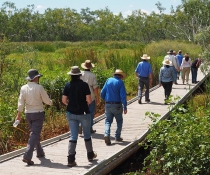Fostering a new generation of scientists
How volunteering with the department led to a career in science.

Standing knee-deep in water identifying bird calls, there was no doubt 10-year-old Curtis Hayne was destined for a career in science.
'My passion for the environment began early from my interest in conservation and wildlife. Originally from Ukraine, I was particularly amazed by the diversity of Australian birdlife. I connected with some community-minded environmentalists and headed out into the field with them regularly,' Curtis said.
Over a decade later, Curtis is a scientist with the NSW Department of Climate Change, Energy, the Environment and Water (DCCEEW).
A chance encounter with a rare species at Whittaker's Lagoon, near Curtis' hometown of Moree in the Gwydir catchment created a desire to continue environmental conservation efforts.
Whittaker's Lagoon is supported by the NSW Government's Water for the Environment program.
'I was going out there monthly with another local birdwatcher,' Curtis explained.
'I was 11 years old at the time, and we spotted a rare species called a comb-crested jacana. It's usually only found in wetlands along the coast and had not been seen in this area for many decades.
'It had travelled all the way to this isolated wetland that had been filled with water for the environment,' Curtis said.
Excited at the discovery, Curtis reported the sighting to the NSW Water for the Environment program's Senior Wetlands and Rivers Conservation Officer, Daryl Albertson.
'Daryl is a very encouraging person, and I subsequently had regular opportunities to get involved,' Curtis said.
Under Daryl's mentorship, Curtis volunteered in the Gwydir, helping survey wildlife, and documenting the results.
'I'd travel out to remote and isolated wetlands, supporting survey teams in any way I could,' he said.
Mr Albertson describes Curtis as a 'success story', demonstrating what can be achieved when we invest in youth.
'Curtis' journey is an example of what can be achieved when we invest in and mentor youth,' Mr Albertson said.
'We can inspire future generations of environmental scientists, conservationists and advocates to engage with the Water for the Environment program.
'It's about succession planning, ensuring future generations take up the challenges we face when working for the environment.
'It's futureproofing for those that came before, that the work they have done will go on.'
When Curtis was in the field, the Gwydir team of Jane Humphries and David Preston supported him on his journey to hone his skills in bird identification and bird survey techniques.
'It was a nice activity to go out on the weekends, be outdoors, and be in the field. Because I started so early, I remembered all the different bird calls.
'By the time I was 15, I knew 200 species of birds just by their calls, so when I went to the bush, I could identify everything immediately.
'I also developed a passion for photography, so I would take my camera along, taking photos where I could and documenting them.'
In 2016, Curtis was nominated by the department and named NSW Student Volunteer of the Year.
'I see the awards as a recognition of my volunteer work and passion for the environment.
'I thank the influential people like Daryl who supported my involvement. My experiences helped shape my future and inspired me to explore a career in science.'
In 2022, Curtis graduated with a Bachelor of Environmental Science at Newcastle University.
What would Curtis say to other budding young scientists?
'Take every opportunity you can. Don't be afraid to try new things; you will be surprised about where life will take you.
'Be passionate about what you do. If you have a passion for something, then do it.
'Volunteer when you can. If you're a student, find work experience so you can determine where you want to go in the future.'





